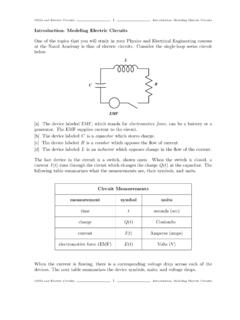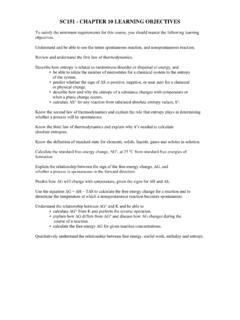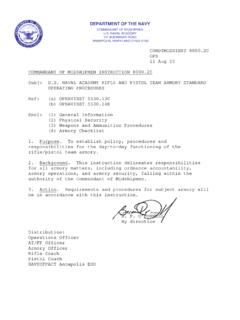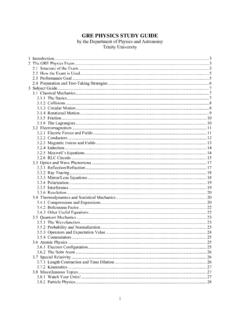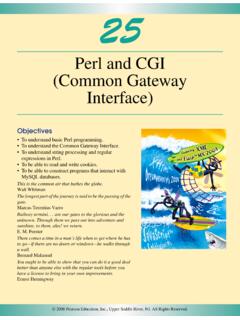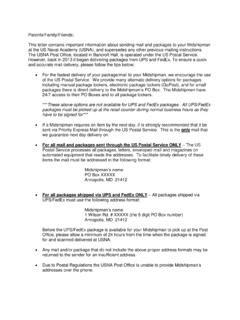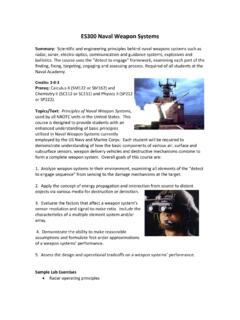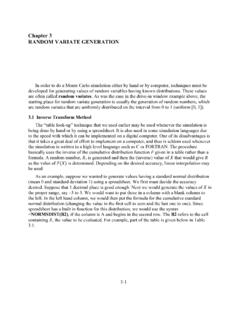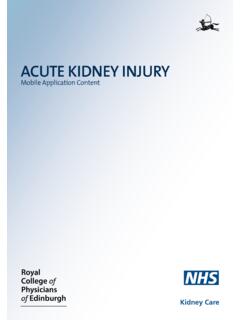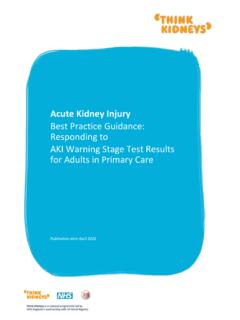Transcription of Appendix A: Medical Considerations for Admissions
1 Medical Apendix A, pg. 1 Appendix A: Medical Considerations for Admissions The Naval Academy program is physically challenging. All candidates are required to undergo a thorough Medical examination because Academy graduates are commissioned in a wide variety of exciting career fields with strict Medical standards. The Medical examination begins during your application process. At that time, the Naval Academy Office of Admissions will upload your name to the Department of Defense Medical Examination Review Board (DoDMERB). DoDMERB will schedule your Medical examination and carefully review the reports to determine if you meet our Medical standards for admission . DoDMERB will consider your Medical history and information on illnesses, injuries, surgeries, familial diseases, and other factors that could affect your Medical status.
2 You may be asked to submit additional reports and/or records from healthcare providers and/or hospitals. Approximately one month after your physical is completed you will receive (by mail) a status report of the DoDMERB findings. If your Admissions record is competitive, and if you are identified to have one or more disqualifying condition(s) for which a waiver might be possible, USNA begins the waiver process. The waiver process involves an in-depth review of your Medical history. Consequently, you may be asked to provide amplifying information on the condition(s) or undergo evaluation by a Medical specialist. A waiver of the Medical standard may be granted if your Medical condition will not prevent you from successfully completing your four years at the Naval Academy and being commissioned in either the Navy or Marine Corps to fulfill your five year service commitment.
3 If you wear glasses or contact lenses, take them with you to your DoDMERB eye examination. If you wear soft contact lenses, do not use them during the three days preceding your examination. Do not use hard or gas permeable lenses for 21 days before your examination. If you are undergoing orthokeratology or other forms of corneal refractive treatment, do not use your rigid lenses for 90 days. Major Medical Considerations are summarized here so that you and your healthcare providers can anticipate if you meet the basic requirements for admission to the Academy. This is not meant to be a comprehensive listing of all disqualifying conditions; it is a brief and general summary for your Eyes and Vision Disqualifications Below is a listing of those eye and vision disqualifications that are the most prevalent.
4 This listing, while comprehensive, does not contain all possible disqualifications for eyes and vision. Vision not correctable to 20/20 in both eyes is disqualifying. Refractive error exceeding + or diopters and astigmatism exceeding diopters is disqualifying. Substandard color vision is disqualifying. Color vision is retested on Induction Day. Many chronic eye diseases/conditions such as keratoconus, glaucoma, optic atrophy, uveitis and retinal degenerations are disqualifying. Procedures to change the refraction (Corneal Refractive Surgery) performed with the excimer laser, including but not limited to photorefractive keratectomy, laser epithelial keratomileusis, and laser-assisted in situ keratomileusis are disqualifying if any of the following conditions are met: the pre-surgical refractive error in either eye exceeded a spherical equivalent of + or diopters, pre-surgical astigmatism exceeded diopters, at least six-month recovery period has not occurred between last refractive surgery or augmenting procedure and accession Medical exam, there have been complications and/or medications or ophthalmologic solutions required and post-surgical refraction in each eye is not stable.
5 Additionally, history of any incisional corneal surgery, including but not limited to partial or full thickness corneal transplant, radial keratotomy, astigmatic keratotomy, or corneal transplants are disqualifying. Medical Apendix A, pg. 2 Height and Weight Standards The minimum qualifying height is 58 inches for all candidates, and the maximum qualifying height for all candidates is 80 inches. Waivers may be granted to a limited number of exceptional candidates whose height exceeds this standard. The minimum qualifying weight (by height) standards are listed in the table. Because of substantial variation in candidates body composition, we apply an estimated body fat percentage when a candidate s weight exceeds the maximum listed. If you do not fall within these standards, we will ask you to provide several measurements with clear instructions so you may ask your gym teacher (perhaps when you take your Candidate Fitness Assessment), a coach, or school nurse to provide the information.
6 In such cases, the qualifying standard is the body fat percentage: no more than 25 percent for men and 35 percent for women, as determined by our protocol. If your weight is at least the minimum and not more than the maximum shown for your height on the preceding table, you will not be asked to provide measurements for the body fat estimate. HEIGHT AND WEIGHT STANDARDS Height (inches) Men Women MIN MAX* MIN MAX* 91 131 91 131 94 136 94 136 97 141 97 141 100 145 100 145 104 150 104 149 107 155 107 152 110 160 110 156 114 165 114 160 117 170 117 163 121 175 121 167 125 181 125 170 128 186 128 174 132 191 132 177 136 196 136 181 140 201 140 185 144 206 144 189 148 211 148 194 152 216 152 200 156 221 156 205 160 226 160 211 164 231 164 216 168 236 168 222 173 241 173 227 *If your weight exceeds that shown for your height, you will be asked to provide measurements from which the Office of Admissions will estimate body fat percentage.
7 Obesity will not be waived. If you exceed the body fat percentage standard on Induction Day, you may be denied admission to enter the Academy. Medical Apendix A, pg. 3 Heart and Vascular System Among the disqualifying conditions are: uncorrected septal defect; congenital, rheumatic, or other abnormality of the heart valves or major vessels; abnormal heart rate or rhythm; blood pressure predominantly in the range of 140/90 or greater; severe or symptomatic varicose veins; and mitral valve prolapse which has either caused symptoms or been associated with rhythm disturbance or regurgitation. Ears and Hearing Both ears must be free of tympanic membrane perforation and acute and chronic disease. The average of the hearing loss at 500, 1000 and 2000 Hz in either ear may not exceed 30 decibels (ISO), and the loss at any one of these three frequencies may not exceed 35 decibels.
8 The maximum acceptable loss in either ear at 3000 Hz is 45 decibels and at 4000 Hz, 55 decibels. Respiratory System A history of asthma, recurrent asthmatic bronchitis, exercise- induced bronchospasm, or reactive airways disease by any other name is disqualifying. Symptomatic nasal polyps, severe hay fever, and tuberculosis (if active within two years) will also result in disqualification. Nasal septal deviation, hypertrophic rhinitis, and other conditions that cause significant reduction of flow through either airway or which interfere with drainage of a sinus are disqualifying. Allergy immunotherapy is disqualifying if received within the 12 months preceding the examination. Musculoskeletal System Un-united fractures, history of surgery to a major joint within six months, history of derangement of any major joint not corrected by surgery or evidence of instability subsequent to surgery, history of anterior or posterior cruciate ligament injury , retained orthopaedic devices, arthritis, severe scoliosis, symptomatic structural abnormalities of the spinal column, and herniated nucleus pulposus or history of spinal surgery for this or any other condition are disqualifying.
9 Genitourinary System Persistence of protein (except documented benign orthostatic proteinuria), sugar, or red or white blood cells in the urine is disqualifying, as are a history of recurrent or bilateral kidney stones. Severe congenital or developmental anomalies, hormonal disorders, neoplastic conditions, persistent or recurrent infections, and certain complications of infections are cause for rejection. An undescended testicle is disqualifying, as are pregnancy, endometriosis, and severe dysmenorrhea. Gastrointestinal System History of peptic ulcer, gastroesophageal reflux disease (GERD), gallbladder disease, regional enteritis (Crohn s Disease), ulcerative colitis, or any other inflammatory bowel disease is disqualifying. Neuropsychiatric Disorders Seizure disorders (but not uncomplicated febrile seizures in childhood), degenerative conditions, traumatic brain injuries, recurrent or severe headaches, and severe motion sickness susceptibility are disqualifying.
10 History of psychosis or affective illness, personality disorder or immaturity, stammering, stuttering, eating disorders such as bulimia and anorexia, and bedwetting or sleepwalking persisting into adolescence also are disqualifying. Academic skills defects, such as learning disabilities or Attention Deficit Hyperactivity Disorder are not disqualifying if academic success can be demonstrated without the use of classroom accommodations, and no medication has been used in the past 12 months, with good grades. Medical Apendix A, pg. 4 Skin Chronic diseases such as psoriasis, atopic dermatitis, and eczema are disqualifying. Severe acne is disqualifying until successfully treated. If a course of Accutane is undertaken, this should be completed, with documentation of a favorable outcome six weeks prior to Induction Day.
